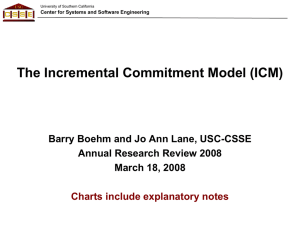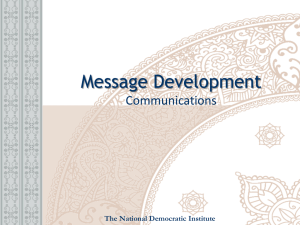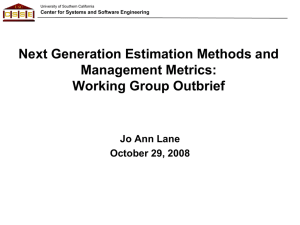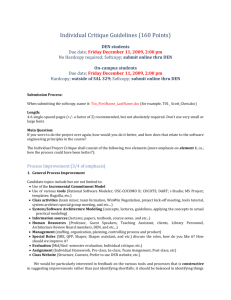ICM Presentation
advertisement
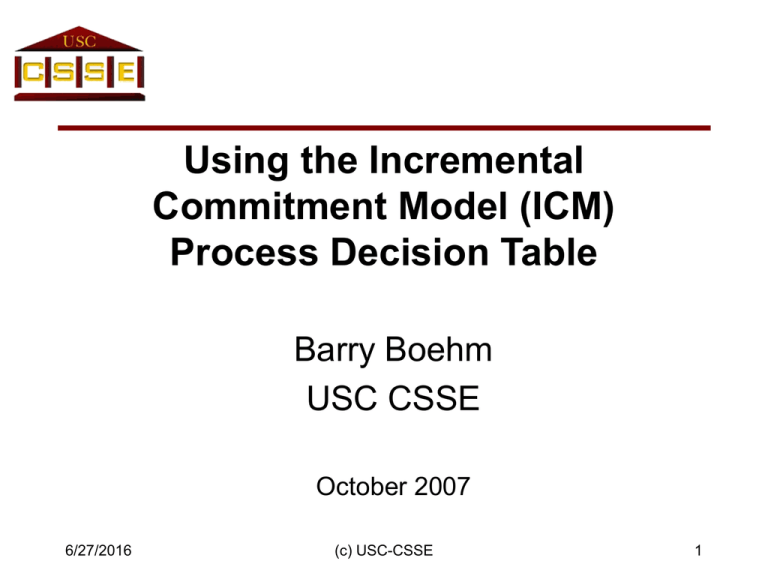
Using the Incremental Commitment Model (ICM) Process Decision Table Barry Boehm USC CSSE October 2007 6/27/2016 (c) USC-CSSE 1 The Incremental Commitment Life Cycle Process: Overview Stage I: Definition Stage II: Development and Operations Anchor Point Milestones Synchronize, stabilize concurrency via FRs Risk patterns determine life cycle process 6/27/2016 (c) USC-CSSE 2 The ICM as Risk-Driven Process Generator • Stage I of the ICM has 3 decision nodes with 4 options/node – Culminating with incremental development in Stage II – Some options involve go-backs – Results in many possible process paths • Can use ICM risk patterns to generate frequentlyused processes – With confidence that they fit the situation • Can generally determine this in the Exploration phase – Develop as proposed plan with risk-based evidence at VCR milestone – Adjustable in later phases 6/27/2016 (c) USC-CSSE 3 The ICM Process Decision Table: Key Decision Inputs • • • • Product and project size and complexity Requirements volatility Mission criticality Nature of Non-developmental Item (NDI) support – Commercial, open-source, reused components • Organizational and Personnel Capability 6/27/2016 (c) USC-CSSE 4 The ICM Process Decision Table: Key Decision Outputs • Key Stage I activities: incremental definition • Key Stage II activities: incremental development and operations • Suggested calendar time per build, per deliverable increment 6/27/2016 (c) USC-CSSE 5 Common Risk-Driven Special Cases of the Incremental Commitment Model (ICM) Special Case Example Size, Comple xity Change Rate % /Month Criticali ty NDI Support 1. Use NDI Small Accounting 2. Agile E-services Low 1 – 30 LowMed Good; in place 3. Scrum of Scrums Business data processing Med 1 – 10 MedHigh 4. SW embedded HW component Multisensor control device Low 0.3 – 1 5. Indivisible IOC Complete vehicle platform Med – High 6. NDIIntensive Supply Chain Management 7. Hybrid agile / plan-driven system Org, Personnel Capability Key Stage I Activities : Incremental Definition Key Stage II Activities: Incremental Development, Operations Acquire NDI Use NDI Agile-ready Med-high Skip Valuation , Architecting phases Scrum plus agile methods of choice <= 1 day; 2-6 weeks Good; most in place Agile-ready Med-high Combine Valuation, Architecting phases. Complete NDI preparation Architecture-based Scrum of Scrums 2-4 weeks; 2-6 months MedVery High Good; In place Experienced; med-high Concurrent HW/SW engineering. CDR-level ICM DCR IOC Development, LRIP, FRP. Concurrent Version N+1 engineering SW: 1-5 days; Marketdriven 0.3 – 1 HighVery High Some in place Experienced; med-high Determine minimum-IOC likely, conservative cost. Add deferrable SW features as risk reserve Drop deferrable features to meet conservative cost. Strong award fee for features not dropped SW: 2-6 weeks; Platform: 618 months Med – High 0.3 – 3 MedVery High NDI-driven architecture NDIexperienced; Med-high Thorough NDI-suite life cycle cost-benefit analysis, selection, concurrent requirements/ architecture definition Pro-active NDI evolution influencing, NDI upgrade synchronization SW: 1-4 weeks; System: 6-18 months C4ISR Med – Very High Mixed parts: 1 – 10 Mixed parts; MedVery High Mixed parts Mixed parts Full ICM; encapsulated agile in high change, low-medium criticality parts (Often HMI, external interfaces) Full ICM ,three-team incremental development, concurrent V&V, nextincrement rebaselining 1-2 months; 9-18 months 8. Multi-owner system of systems Net-centric military operations Very High Mixed parts: 1 – 10 Very High Many NDIs; some in place Related experience, med-high Full ICM; extensive multiowner team building, negotiation Full ICM; large ongoing system/software engineering effort 2-4 months; 18-24 months 9. Family of systems Medical Device Product Line Med – Very High 1–3 Med – Very High Some in place Related experience, med – high Full ICM; Full stakeholder participation in product line scoping. Strong business case Full ICM. Extra resources for first system, version control, multi-stakeholder support 1-2 months; 9-18 months Complete C4ISR: Command, Control, Computing, Communications, Intelligence, Surveillance, Reconnaissance. CDR: Critical Design Review. DCR: Development Commitment Review. FRP: Full-Rate Production. HMI: Human-Machine Interface. HW: Hard ware. 6/27/2016 (c) USC-CSSE IOC: Initial Operational Capability. LRIP: Low-Rate Initial Production. NDI: Non-Development Item. SW: Software Time per Build; per Increment 6 Special Case I: Use NDI • Exploration phase identifies NDI opportunities • NDI risk/opportunity analysis indicates risks acceptable – Product growth envelope fits within NDI capability – Compatible NDI and product evolution paths – Acceptable NDI volatility • Some open-source components highly volatile – Acceptable usability, dependability, interoperability – NDI available or affordable 6/27/2016 (c) USC-CSSE 7 Special Case 2: Pure Agile • Exploration phase determines – Low product and project size and complexity – Fixing increment defects in next increment acceptable – Existing hardware and NDI support of growth envelope – Sufficient agile-capable personnel – Need to accommodate rapid change, emergent requirements, early user capability • At least daily builds, 2-6 week delivery increments recommended 6/27/2016 (c) USC-CSSE 8 Special Case 3: Scrum of Scrums • Exploration phase determines – Need to accommodate fairly rapid change, emergent requirements, early user capability – Low risk of scalability up to 100 people – NDI support of growth envelope – Nucleus of highly agile-capable personnel – Moderate to high loss due to increment defects • Several teams using Scrum techniques – Roughly 10-person teams; Scrum Master; 2-4 week, timeboxed, increment sprints; prioritized backlog; daily standup meetings – Followed by daily standup meeting of teams’ Scrum Masters 6/27/2016 (c) USC-CSSE 9 Scrum of Scrums: Critical Success Factors • Management commitment, with incremental feasibility checkpoints – – – – Clear message about objectives, scope, and strategy Involve top people from stakeholder organizations Build in growth to expansion sites Lead through early successes • Thoroughly prepare the ground – Infrastructure, policies, practices, roles, training – Customer buy-in and expectations management – Get help from experts • Make clear what’s essential, optional – Most frequently, Scrum plus organizational essentials – Precede Development Sprints by Architecting Sprint • Follow by Release Sprint, beta testing – Where needed, work compliant mandate interpretations • CMMI, ISO, SPICE, Sarbanes-Oxley • Monitor, reflect, learn, evolve 6/27/2016 (c) USC-CSSE 10 Special Case 4: Software Embedded Hardware Component • Example: Multisensor Control Device • Biggest risks: Device recall, lawsuits, production line rework, hardware-software integration – DCR carried to Critical Design Review level – Concurrent hardware-software design • Criticality makes Agile too risky – Continuous hardware-software integration • Initially with simulated hardware • Low risk of overrun – Low complexity, stable requirements and NDI – Little need for risk reserve • Likely single-supplier software makes daily-weekly builds feasible 6/27/2016 (c) USC-CSSE 11 Special Case 5: Indivisible IOC - Initial Operational Capability • Example: Complete Vehicle Platform • Biggest risk: Complexity, NDI uncertainties cause cost-schedule overrun – Similar strategies to case 4 for criticality (CDR, concurrent HW-SW design, continuous integration) – Add deferrable software features as risk reserve • Adopt conservative (90% sure) cost and schedule • Drop software features to meet cost and schedule • Strong award fee for features not dropped – Likely multiple-supplier software makes longer (multi-weekly) builds more necessary 6/27/2016 (c) USC-CSSE 12 Special Case 6: NDI-Intensive • Example: Supply Chain Management – NDI Enterprise Resource Planning, manufacturing, logistics, Customer Relations Management, marketing packages • Biggest risks: incompatible NDI; rapid change, business/mission criticality; low NDI assessment and integration experience; supply chain stakeholder incompatibilities • Key Stage I activities: thorough NDI capability/compatibility assessment, concurrent requirement/architecture definition, NDI shortfall fallback plans • Key Stage II activities: Pro-active NDI evolution influencing, multiple-NDI upgrade synchronization 6/27/2016 (c) USC-CSSE 13 Special Case 7: Hybrid Agile/Plan-Driven System • Example: Command and Control (urban, military) – Sensor processing, data fusion, situation understanding, platform dispatching and management • Biggest risks: large scale, high complexity, rapid change, mixed high/low criticality, partial NDI support, mixed personnel capability • Key Stage I activities: extensive risk-driven prototyping, modeling, simulation, feasibility analysis; early development of high-risk elements; architecting to enable concurrent agile and plan-driven development • Key Stage II activities: full ICM concurrent 3-team development and next-increment rebaselining • 1-2 Months per build; 9-18 months per major release 6/27/2016 (c) USC-CSSE 14 Special Case 8: Multi-Owner System of Systems • Biggest risks: all those of Case 7 plus – Need to synchronize, integrate separately-managed, independently-evolving systems – Extremely large-scale; deep supplier hierarchies – Rapid adaptation to change extremely difficult • Key Stage I activities: scale-up of Case 7 plus extensive teambuilding, development of integration infrastructure and integration and test facilities • Key Stage II activities: scale-up of Case 7 plus multiple concurrent version control, more complex change management 6/27/2016 (c) USC-CSSE 15 Special Case 9: Family of Systems • Example: Medical Device Product Line – Common domain architecture reflecting product line element commonalities and variabilities • Biggest risks: Product line too broad (noncompetitive) or too narrow (few reuse opportunities); product line divergence; version proliferation and change management; NDI compatibility • Key Stage I activities: domain engineering, product line architecting, feasibility analysis, market analysis • Key Stage II activities: next-increment feature prioritization; high-assurance common-component development and certification; version control and change management; market trend analysis 6/27/2016 (c) USC-CSSE 16 Frequently Asked Question • Q: Having all that ICM generality and then using the decision table to come back to a simple model seems like an overkill. – If my risk patterns are stable, can’t I just use the special case indicated by the decision table? • A: Yes, you can and should – as long as your risk patterns stay stable. But as you encounter change, the ICM helps you adapt to it. – And it helps you collaborate with other organizations that may use different special cases. 6/27/2016 (c) USC-CSSE 17 References • Boehm, B. “Implementing Risk Management”, in B. Boehm (ed.), Software Risk Management, IEEE CS Press, 1989, pp.433-440, Also in R. Selby(ed.), Software Engineering: Barry W. Boehm’s Contribution to Software Development, Management, and Research, Wiley, 2007, pp 481-492. • Boehm, B., and R. Turner, Balancing Agility and Discipline, Addison Wesley, 2004 • Pew, R., and A. Mavor, Human System Integration in the System Development Process: A New Look, National Academies Press, 2007. • Boehm, B., and J. Lane, “Using the Incremental Commitment Model to Integrate System Acquisition, Systems Engineering, and Software Engineering”, USC-CSSE-TR-2207, (Short Version in Cross Talk, October 2007, pp, 4-9) 6/27/2016 (c) USC-CSSE 18

